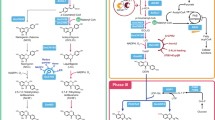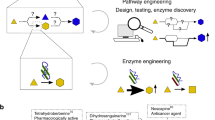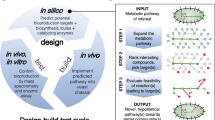Abstract
Throughout human history, natural products have been the foundation for the discovery and development of therapeutics used to treat diseases ranging from cardiovascular disease to cancer. Their chemical diversity and complexity have provided structural scaffolds for small-molecule drugs and have consistently served as inspiration for medicinal design. However, the chemical complexity of natural products also presents one of the main roadblocks for production of these pharmaceuticals on an industrial scale. Chemical synthesis of natural products is often difficult and expensive, and isolation from their natural sources is also typically low yielding. Synthetic biology and metabolic engineering offer an alternative approach that is becoming more accessible as the tools for engineering microbes are further developed. By reconstructing heterologous metabolic pathways in genetically tractable host organisms, complex natural products can be produced from inexpensive sugar starting materials through large-scale fermentation processes. In this Perspective, we discuss ongoing research aimed toward the production of terpenoid natural products in genetically engineered Escherichia coli and Saccharomyces cerevisiae.
This is a preview of subscription content, access via your institution
Access options
Subscribe to this journal
Receive 12 print issues and online access
$259.00 per year
only $21.58 per issue
Buy this article
- Purchase on Springer Link
- Instant access to full article PDF
Prices may be subject to local taxes which are calculated during checkout


Similar content being viewed by others
References
Newman, D.J., Cragg, G.M. & Snader, K.M. The influence of natural products upon drug discovery (Antiquity to late 1999). Nat. Prod. Rep. 17, 215–234 (2000).
Koehn, F.E. & Carter, G.T. The evolving role of natural products in drug discovery. Nat. Rev. Drug Discov. 4, 206–220 (2005).
Newman, D.J., Cragg, G.M. & Snader, K.M. Natural products as sources of new drugs over the period 1981–2002. J. Nat. Prod. 66, 1022–1037 (2003).
Horwitz, S.B. How to make taxol from scratch. Nature 367, 593–594 (1994).
McNeil, D.G.J. “Plant shortage leaves campaigns against malaria at risk.” New York Times 14 November 2004.
Khosla, C. & Keasling, J.D. Metabolic engineering for drug discovery and development. Nat. Rev. Drug Discov. 2, 1019–1025 (2003).
Glazer, A.N. & Nikaido, H. Microbial Biotechnology: Fundamentals of Applied Microbiology (WH. Freeman and Co., New York, 1995).
Stephanopoulos, G.N., Aristidou, A.A. & Nielsen, J. Metabolic Engineering: Principles and Methodologies (Academic, New York, 1998).
Ensley, B.D. et al. Expression of naphthalene oxidation genes in Escherichia coli results in the biosynthesis of indigo. Science 222, 167–169 (1983).
Mermod, N., Haryama, S. & Timmis, K.N. New route to bacterial production of indigo. Bio/Technology 4, 321–324 (1986).
Slater, S.C., Voige, W.H. & Dennis, D.E. Cloning and expression in Escherichia coli of the Alcaligenes eutrophus H16 poly-β-hydroxybutyrate biosynthetic pathway. J. Bacteriol. 170, 4431–4436 (1988).
Schubert, P., Steinbüchel, A. & Schlegel, H.G. Cloning of the Alcaligenes eutrophus genes for synthesis of poly-β-hydroxybutyric acid (PHB) and synthesis of PHB in Escherichia coli. J. Bacteriol. 170, 5837–5847 (1988).
Peoples, O.P. & Sinskey, A.J. Poly-β-hydroxybutyrate (PHB) biosynthesis in Alcaligenes eutrophus H16. Identification and characterization of the PHB polymerase gene (phbC). J. Biol. Chem. 264, 15298–15303 (1989).
Nakamura, C.E. & Whited, G.M. Metabolic engineering for the microbial production of 1,3-propanediol. Curr. Opin. Biotechnol. 14, 454–459 (2003).
Hopwood, D.A. et al. Production of 'hybrid' antibiotics by genetic engineering. Nature 314, 642–644 (1985).
Stanzak, R., Matsushima, P., Baltz, R.H. & Rao, R.N. Cloning and expression in Streptomyces lividans of clustered erythromycin biosynthesis genes from Streptomyces erythreus. Bio/Technology 4, 229–232 (1986).
Tang, L. et al. Cloning and heterologous expression of the epothilone gene cluster. Science 287, 640–642 (2000).
Pfeifer, B.A. & Khosla, C. Biosynthesis of polyketides in heterologous hosts. Microbiol. Mol. Biol. Rev. 65, 106–118 (2001).
Menzella, H.G. et al. Combinatorial polyketide biosynthesis by de novo design and rearrangement of modular polyketide synthase genes. Nat. Biotechnol. 23, 1171–1176 (2005).
Pfeifer, B.A., Admiraal, S.J., Gramajo, H., Cane, D.E. & Khosla, C. Biosynthesis of complex polyketides in a metabolically engineered strain of E. coli. Science 291, 1790–1792 (2001).
Lau, J., Tran, C., Licari, P. & Galazzo, J. Development of a high cell-density fed-batch bioprocess for the heterologous production of 6-deoxyerythronolide B in Escherichia coli. J. Biotechnol. 110, 95–103 (2004).
Mutka, S.C., Bondi, S.M., Carney, J.R., Da Silva, N.A. & Kealey, J.T. Metabolic pathway engineering for complex polyketide biosynthesis in S. cerevisiae. FEMS Yeast Res. 6, 40–47 (2006).
Kealey, J.T., Liu, L., Santi, D.V., Betlach, M.C. & Barr, P.J. Production of a polyketide natural product in nonpolyketide-producing prokaryotic and eukaryotic hosts. Proc. Natl. Acad. Sci. USA 95, 505–509 (1998).
Conolly, J.D. & Hill, R.A. Dictionary of Terpenoids (Chapman & Hall, London, 1991).
Harborne, J.B. in Ecological Chemistry and Biochemistry of Plant Terpenoids (eds. Harborne, J.B. & Tomas-Barberan, F.F.) 399–426 (Clarendon Press, Oxford, 1991).
McCaskill, D. & Croteau, R. Prospects for the bioengineering of isoprenoid biosynthesis. Adv. Biochem. Eng. Biotechnol. 55, 107–146 (1997).
Spurgeon, S.L. & Porter, J.W. (eds.) Biosynthesis of Isoprenoid Compounds (Wiley, New York, 1981).
Rohmer, M., Knani, M., Simonin, P., Sutter, B. & Sahm, H. Isoprenoid biosynthesis in bacteria: a novel pathway for the early steps leading to isopentenyl diphosphate. Biochem. J. 295, 517–524 (1993).
Rohdich, F., Hecht, S., Bacher, A. & Eisenreich, W. Deoxyxylulose phosphate pathway of isoprenoid biosynthesis. Discovery and function of ispDEFGH genes and their cognate enzymes. Pure Appl. Chem. 75, 393–405 (2003).
Lange, B.M., Rujan, T., Martin, W. & Croteau, R. Isoprenoid biosynthesis: the evolution of two ancient and distinct pathways across genomes. Proc. Natl. Acad. Sci. USA 97, 13172–13177 (2000).
Rohdich, F. et al. Studies on the nonmevalonate terpene biosynthetic pathway: metabolic role of IspH (LytB) protein. Proc. Natl. Acad. Sci. USA 99, 1158–1163 (2002).
Albrecht, M., Misawa, N. & Sandmann, G. Metabolic engineering of the terpenoid biosynthetic pathway of Escherichia coli for production of the carotenoids β-carotene and zeaxanthin. Biotechnol. Lett. 21, 791–795 (1999).
Matthews, P.D. & Wurtzel, E.T. Metabolic engineering of carotenoid accumulation in Escherichia coli by modulation of the isoprenoid precursor pool with expression of deoxyxylulose phosphate synthase. Appl. Environ. Microbiol. 53, 396–400 (2000).
Kim, S.-W. & Keasling, J.D. Metabolic engineering of the nonmevalonate isopentenyl diphosphate synthesis pathway in Escherichia coli enhances lycopene production. Biotechnol. Bioeng. 72, 408–415 (2001).
Kajiwara, S., Fraser, P.D., Kondo, K. & Misawa, N. Expression of an exogenous isopentenyl diphosphate isomerase gene enhances isoprenoid biosynthesis in Escherichia coli. Biochem. J. 324, 421–426 (1997).
Neudert, U., Martinez-Ferez, I.M., Fraser, P.D. & Sandmann, G. Expression of an active phytoene synthase from Erwinia uredovora and biochemical properties of the enzyme. Biochim. Biophys. Acta 1392, 51–58 (1998).
Wang, C.W., Oh, M.K. & Liao, J.C. Engineered isoprenoid pathway enhances astaxantin production in Escherichia coli. Biotechnol. Bioeng. 62, 235–241 (1999).
Farmer, W.R. & Liao, J.C. Precursor balancing for metabolic engineering of lycopene production in Escherichia coli. Biotechnol. Prog. 17, 57–61 (2001).
Farmer, W.R. & Liao, J.C. Improving lycopene production in Escherichia coli by engineering metabolic control. Nat. Biotechnol. 18, 533–537 (2000).
Martin, V.J., Pitera, D.J., Withers, S.T., Newman, J.D. & Keasling, J.D. Engineering a mevalonate pathway in Escherichia coli for production of terpenoids. Nat. Biotechnol. 21, 796–802 (2003).
Kakinuma, K. et al. New approach to multiply deuterated isoprenoids using triply engineered Escherichia coli and its potential as a tool for mechanistic enzymology. J. Am. Chem. Soc. 123, 1238–1239 (2001).
Martin, V.J., Yoshikuni, Y. & Keasling, J.D. The in vivo synthesis of plant sesquiterpenes by Escherichia coli. Biotechnol. Bioeng. 75, 497–503 (2001).
Mercke, P., Bengtsson, M., Bouwmeester, H.J., Posthumus, M.A. & Brodelius, P.E. Molecular cloning, expression, and characterization of amorpha-4,11-diene synthase, a key enzyme of artemisinin biosynthesis in Artemisia annua L. Arch. Biochem. Biophys. 381, 173–180 (2000).
Chang, Y.J., Song, S.H., Park, S.H. & Kim, S.U. Amorpha-4,11-diene synthase of Artemisia annua: cDNA isolation and bacterial expression of a terpene synthase involved in artemisinin biosynthesis. Arch. Biochem. Biophys. 383, 178–184 (2000).
Newman, J.D. et al. High-level production of amorpha-4,11-diene in a two-phase partitioning bioreactor of metabolically engineered Escherichia coli. Biotechnol. Bioeng. 95, 684–691 (2006).
Pitera, D.J., Paddon, C., Newman, J.D. & Keasling, J.D. Rebuilding a balanced heterologous mevalonate pathway for isoprenoid production in Escherichia coli. Metab. Eng. (submitted).
Pfleger, B.F., Pitera, D.J., Smolke, C.D. & Keasling, J.D. Combinatorial engineering of intergenic regions in operons tunes expression of multiple genes. Nat. Biotechnol. 24, 1027–1032 (2006).
Yuan, L.Z., Rouviere, P.E., Larossa, R.A. & Suh, W. Chromosomal promoter replacement of the isoprenoid pathway for enhancing carotenoid production in E. coli. Metab. Eng. 8, 79–90 (2006).
Donald, K., Hampton, R. & Fritz, I. Effects of overproduction of the catalytic domain of 3-hydroxy-3-methylglutaryl coenzyme A reductase on squalene synthesis in Saccharomyces cerevisiae. Appl. Environ. Microbiol. 63, 3341–3344 (1997).
Polakowski, T., Stahl, U. & Lang, C. Overexpression of a cytosolic hydroxymethylglutaryl-CoA reductase leads to squalene accumulation in yeast. Appl. Microbiol. Biotechnol. 49, 66–71 (1998).
Duport, C., Spagnoli, R., Degryse, E. & Pompon, D. Self-sufficient biosynthesis of pregnenolone and progesterone in engineered yeast. Nat. Biotechnol. 16, 186–189 (1998).
Szczebara, F.M. et al. Total biosynthesis of hydrocortisone from a simple carbon source in yeast. Nat. Biotechnol. 21, 143–149 (2003).
Shimada, H. et al. Increased carotenoid production by the food yeast Candida utilis through metabolic engineering of the isoprenoid pathway. Appl. Environ. Microbiol. 64, 2676–2680 (1998).
Szkopinska, A., Swiezewska, E. & Karst, F. The regulation of activity of main mevalonic acid pathway enzymes: farnesyl diphosphate synthase, 3-hydroxy-3-methylglutaryl-CoA reductase, and squalene synthase in yeast S. cerevisiae. Biochem. Biophys. Res. Commun. 267, 473–477 (2000).
Jackson, B.E., Hart-Wells, E.A. & Matsuda, S.P.T. Metabolic engineering to produce sesquiterpenes in yeast. Org. Lett. 5, 1629–1632 (2003).
Ro, D.K. et al. Production of the antimalarial drug precursor artemisinic acid in engineered yeast. Nature 440, 940–943 (2006).
DeJong, J.M. et al. Genetic engineering of taxol biosynthetic genes in Saccharomyces cerevisiae. Biotechnol. Bioeng. 93, 212–224 (2006).
Causey, T.B., Zhou, S., Shanmugam, K.T. & Ingram, L.O. Engineering the metabolism of Escherichia coli W3110 for the conversion of sugar to redox-neutral and oxidized products: homoacetate production. Proc. Natl. Acad. Sci. USA 100, 825–832 (2003).
Causey, T.B., Shanmugam, K.T., Yomano, L.P. & Ingram, L.O. Engineering Escherichia coli for efficient conversion of glucose to pyruvate. Proc. Natl. Acad. Sci. USA 101, 2235–2240 (2004).
Aristidou, A.A., San, K.-Y. & Bennett, G.N. Modification of central metabolic pathway in Escherichia coli to reduce acetate accumulation by heterologous expression of the Bacillus subtilis acetolactate synthase gene. Biotechnol. Bioeng. 44, 944–951 (2004).
Alper, H., Jin, Y.S., Moxley, J.F. & Stephanopoulos, G. Identifying gene targets for the metabolic engineering of lycopene biosynthesis in Escherichia coli. Metab. Eng. 7, 155–164 (2005).
Alper, H., Miyaoku, K. & Stephanopoulos, G. Construction of lycopene-overproducing E. coli strains by combining systematic and combinatorial gene knockout targets. Nat. Biotechnol. 23, 612–616 (2005).
Hemmi, H., Ohnuma, S., Nagaoka, K. & Nishino, T. Identification of genes affecting lycopene formation in Escherichia coli transformed with carotenoid biosynthetic genes: candidates for early genes in isoprenoid biosynthesis. J. Biochem. 123, 1088–1096 (1998).
Varma, A. & Palsson, B.O. Metabolic flux balancing: basic concepts, scientific and practical use. Bio/Technology 12, 994–998 (1994).
Stephanopoulos, G. Metabolic fluxes and metabolic engineering. Metab. Eng. 1, 1–11 (1999).
Fischer, E. & Sauer, U. Metabolic flux profiling of Escherichia coli mutants in central carbon metabolism using GC-MS. Eur. J. Biochem. 270, 880–891 (2003).
Sauer, U. High-throughput phenomics: experimental methods for mapping fluxomes. Curr. Opin. Biotechnol. 15, 58–63 (2004).
Bayer, T.S. & Smolke, C.D. Programmable ligand-controlled riboregulators of eukaryotic gene expression. Nat. Biotechnol. 23, 337–343 (2005).
Bennett, M.D. & Smith, J.B. Nuclear DNA amounts in angiosperms. Philos. Trans. R. Soc. Lond. B Biol. Sci. 274, 227–274 (1976).
Yoshikuni, Y., Martin, V.J., Ferrin, T.E. & Keasling, J.D. Engineering cotton (+)-δ-cadinene synthase to an altered function: germacrene D-4-ol synthase. Chem. Biol. 13, 91–98 (2006).
Yoshikuni, Y., Ferrin, T.E. & Keasling, J.D. Designed divergent evolution of enzyme function. Nature 440, 1078–1082 (2006).
Cirino, P.C. & Arnold, F.A. Protein engineering of oxygenases for biocatalysis. Curr. Opin. Chem. Biol. 6, 130–135 (2002).
Sowden, R.J., Yasmin, S., Rees, N.H., Bell, S.G. & Wong, L.L. Biotransformation of the sesquiterpene (+)-valencene by cytochrome P450cam and P450BM-3. Org. Biomol. Chem. 3, 57–64 (2005).
Wani, M.C., Taylor, H.L., Wall, M.E., Coggon, P. & McPhail, A.T. Plant antitumor agents. VI. The isolation and structure of taxol, a novel antileukemic and antitumor agent from Taxus brevifolia. J. Am. Chem. Soc. 93, 2325–2327 (1971).
Jennewein, S., Wildung, M.R., Chau, M., Walker, K. & Croteau, R. Random sequencing of an induced Taxus cell cDNA library for identification of clones involved in taxol biosynthesis. Proc. Natl. Acad. Sci. USA 101, 9149–9154 (2004).
Wildung, M.R. & Croteau, R. A cDNA clone for taxadiene synthase, the diterpene cyclase that catalyzes the committed step of taxol biosynthesis. J. Biol. Chem. 271, 9201–9204 (1996).
Walker, K. & Croteau, R. Molecular cloning of a 10-deacetylbaccatin III-10-O-acetyl transferase cDNA from Taxus and functional expression in Escherichia coli. Proc. Natl. Acad. Sci. USA 97, 583–587 (2000).
Walker, K. & Croteau, R. Taxol biosynthesis: molecular cloning of a benzoyl-CoA:taxane 2α-O-benzoyltransferase cDNA from Taxus and functional expression in Escherichia coli. Proc. Natl. Acad. Sci. USA 97, 13591–13596 (2000).
Walker, K., Schoendorf, A. & Croteau, R. Molecular cloning of a taxa-4(20),11(12)-dien-5α-ol-O-acetyl transferase cDNA from Taxus and functional expression in Escherichia coli. Arch. Biochem. Biophys. 374, 371–380 (2000).
Schoendorf, A., Rithner, C.D., Williams, R.M. & Croteau, R.B. Molecular cloning of a cytochrome P450 taxane 10β-hydroxylase cDNA from Taxus and functional expression in yeast. Proc. Natl. Acad. Sci. USA 98, 1501–1506 (2001).
Jennewein, S., Rithner, C.D., Williams, R.M. & Croteau, R. Taxol biosynthesis: taxane 13α-hydroxylase is a cytochrome P450-dependent monooxygenase. Proc. Natl. Acad. Sci. USA 98, 13595–13600 (2001).
Jennewein, S., Long, R.M., Williams, R.M. & Croteau, R. Cytochrome P450 taxadiene 5α-hydroxylase, a mechanistically unusual monooxygenase catalyzing the first oxygenation step of taxol biosynthesis. Chem. Biol. 11, 379–387 (2004).
Chau, M., Jennewein, S., Walker, K. & Croteau, R. Taxol biosynthesis: molecular cloning and characterization of a cytochrome P450 taxoid 7β-hydroxylase. Chem. Biol. 11, 663–672 (2004).
Chau, M. & Croteau, R. Molecular cloning and characterization of a cytochrome P450 taxoid 2α-hydroxylase involved in taxol biosynthesis. Arch. Biochem. Biophys. 427, 48–57 (2004).
Walker, K., Long, R. & Croteau, R. The final acylation step in taxol biosynthesis: cloning of the taxoid C13-side chain N-benzoyltransferase. Proc. Natl. Acad. Sci. USA 99, 9166–9171 (2002).
Walker, K.D., Klettke, K., Akiyama, T. & Croteau, R. Cloning, heterologous expression, and characterization of a phenylalanine aminomutase involved in taxol biosynthesis. J. Biol. Chem. 279, 53947–53954 (2004).
Huang, Q., Roessner, C.A., Croteau, R. & Scott, A.I. Engineering Escherichia coli for the synthesis of taxadiene, a key intermediate in the biosynthesis of taxol. Bioorg. Med. Chem. 9, 2237–2242 (2001).
Hefner, J., Ketchum, R.E.B. & Croteau, R. Cloning and functional expression of a cDNA encoding geranylgeranyl diphosphate synthase from Taxus canadensis and assessment of the role of this prenyltransferase in cells induced for Taxol production. Arch. Biochem. Biophys. 360, 62–74 (1998).
Korenromp, E., Miller, J., Nahlen, B., Wardlaw, T. & Young, M. World Malaria Report 2005 (World Health Organization, Roll Back Malaria, Geneva, 2005).
Dhingra, V. & Narasu, M.L. Purification and characterization of an enzyme involved in biochemical transformation of arteannuin B to artemisinin from Artemisia annua. Biochem. Biophys. Res. Commun. 281, 558–561 (2001).
Wallaart, T.E. et al. Isolation and identification of dihydroartemisinic acid from Artemisia annua and its possible role in the biosynthesis of artemisinin. J. Nat. Prod. 62, 430–433 (1999).
Roth, R.J. & Acton, N. A simple conversion of artemisinic acid into artemisinin. J. Nat. Prod. 52, 1183–1185 (1989).
Bertea, C.M. et al. Identification of intermediates and enzymes involved in the early steps of artemisinin biosynthesis in Artemisia annua. Planta Med. 71, 40–47 (2005).
Schuler, M.A. & Werck-Reichhart, D. Functional genomics of P450s. Annu. Rev. Plant Biol. 54, 629–667 (2003).
Teoh, K.H., Polichuk, D.R., Reed, D.W., Nowak, G. & Covello, P.S. Artemisia annua L. (Asteraceae) trichome-specific cDNAs reveal CYP71AV1, a cytochrome P450 with a key role in the biosynthesis of the antimalarial sesquiterpene lactone artemisinin. FEBS Lett. 580, 1411–1416 (2006).
Acknowledgements
We would like to thank D. Pitera, E. Paradise and D.-K. Ro for helpful discussions. M.C.Y.C acknowledges a postdoctoral fellowship from the Jane Coffin Childs Memorial Fund. Isoprenoid research in the Keasling laboratory has been funded by the University of California Discovery Grant Program, the US National Science Foundation, Maxygen, Diversa and the Bill & Melinda Gates Foundation.
Author information
Authors and Affiliations
Corresponding author
Ethics declarations
Competing interests
Jay Keasling is a founder of Amyris Biotechnologies, a company that may eventually use the gene and engineered yeast described in the publication Nature 440, 940-943 (2006) to produce artemisinin. However, neither Amyris Biotechnologies nor the University of California will make any profit from the production and sale of artemisinin, the anti-malarial drug.
Rights and permissions
About this article
Cite this article
Chang, M., Keasling, J. Production of isoprenoid pharmaceuticals by engineered microbes. Nat Chem Biol 2, 674–681 (2006). https://doi.org/10.1038/nchembio836
Published:
Issue Date:
DOI: https://doi.org/10.1038/nchembio836
This article is cited by
-
Recent Advances in Microbial Production of Terpenoids from Biomass-derived Feedstocks
Chemical Research in Chinese Universities (2024)
-
Improved polyketide production in C. glutamicum by preventing propionate-induced growth inhibition
Nature Metabolism (2023)
-
Insights into Regulating Mechanism of Mutagenesis Strains of Elizabethkingia meningoseptica sp. F2 by Omics Analysis
Current Microbiology (2023)
-
Quantitative Methods for Metabolite Analysis in Metabolic Engineering
Biotechnology and Bioprocess Engineering (2023)
-
Functional mining of novel terpene synthases from metagenomes
Biotechnology for Biofuels and Bioproducts (2022)



